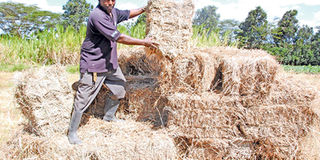Let us exploit high potential in hay export

Samwel Mambo showcases bales of Boma Rhodes in his farm in Rongai, Nakuru County. PHOTO | FILE | NMG
What you need to know:
We need a change of mindset and treat Rhodes grass as a purposely grown crop that meets import standards.
Infringements based on plant diseases, pests and weeds lead to unilateral product ban for the whole country.
An example is the current export ban on Kenyan mangoes to the lucrative European and US markets due to fruit fly infestation.
The international trade in fodder has seen a steady rise in recent years, owing to increased meat and milk consumption, lack of suitable arable land and unfavourable weather in importing countries.
The depletion of underground water resources has also forced a reduction in irrigated fodder.
While Lucerne is the preferred export fodder for its high protein content, there is still a market share for grass hays such as Rhodes grass, which is common in Kenya.
Geographically, Kenya is well located to take advantage of the inexpensive ocean transport system in the return ships offloading at Mombasa. Secondly, we have plenty of arable land in Asal (arid and semi-arid lands) regions, which, with good farming practices, can support large-scale and mechanised hay production.
However, we need to be cognisant of the fact that the Rhodes grass hay export market is competitive with the United States, Canada, Spain and Pakistan being the main players, according to the International Trade Centre. There are also standards on nutritional value, zero tolerance on pests and vectors and weeds and disease-causing organisms, such as moulds caused by poor drying. In this age, the human, animal and ecological welfare are closely interlinked and trade in contaminated food crops can be a threat to it.
However, we need a change of mindset and treat Rhodes grass as a purposely grown crop that meets import standards.
Fortunately, we have a history of exporting food crops, such as French beans, under the watch of regulatory authorities like the Kenya Plant Health Inspectorate Service (Kephis), and they can guide the hay export sector to conform to all international standards.
If traders play unregulated — based on hay pictures, nutritional tests that do not match consignments, weights that may not meet tendering specifications — we might soon be blacklisted for infringements.
Infringements based on plant diseases, pests and weeds lead to unilateral product ban for the whole country. An example is the current export ban on Kenyan mangoes to the lucrative European and US markets due to fruit fly infestation.
As seen in the recently launched campaign to eradicate fruit fly — Komesha: Zuia Fruit Fly Ufaidike, by Makueni County in collaboration with USAid — it takes effort, time and money to clear a bad name.
Just like with horticultural produce for export, most Kenyan hay is grown by small-scale farmers and ‘telephone farmers’ drawn to the crop on the promise that it is easy to grow.
This “ease” is what largely contributes to lack of fertilising, harvesting of overgrown grass and poor drying, which make the hay a high-risk export.
The tri-party relationship of regulatory authorities, exporters and smallholder farmers, is the bedrock of our successful horticultural sector.
When it is infiltrated by middlemen, who only appear at harvesting time, quality is compromised and it’s often followed by a ban. An example is the recent ban on avocado export due to harvesting of immature fruits.
Such a tri-party relationship will decide if Kenya can successfully get into the hay export market.
Ms Munene is the manager, Lukuai Hay Farm, Laikipia. [email protected].



